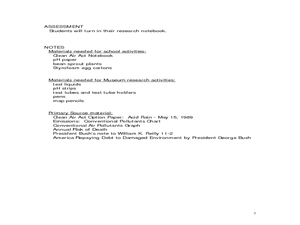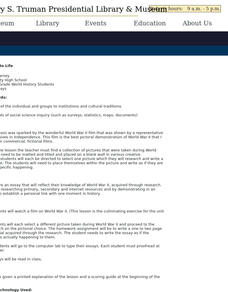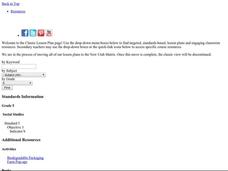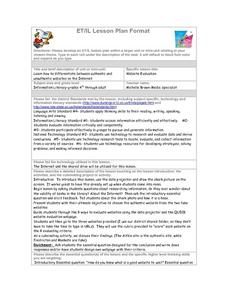Curated OER
Why Not Come to North Amercia?
Students examine the motives for French expansion into the New World, they evaluate primary source documents to determine who, what, when, where and why.
Curated OER
Treaty Trail: Crossing the Bitterroot Mountains
Students examine art and primary documents that depicts the Native Americans' crossing of Washington's Bitterroot Mountains to arrive at the Spokane Council. Students investigate and compare maps and other historical materials determine...
Curated OER
Persuasive Speech
Tenth graders participate in a lesson that is focused on the concept of writing persuasive speechs. They conduct research from a variety of sources in order to gather information to write well informed speeches.
Curated OER
Labor Needs in Colonial America
Students examine the labor needs in colonial America. Using primary and secondary resources, they explore the major events and life in the United States during colonial times. They complete a chart listing the pros and cons of a slave...
Curated OER
Will the Real Ben Franklin Please Stand Up?
Students explore the life of Benjamin Franklin. In this American history lesson, students research primary and secondary documents regarding Franklin's life. Students should examine the point of view each of the accounts is written from...
Curated OER
The Roanoke Mystery
Fourth graders hypothesize about what happened on the island of Roanoke. In this South Carolina history instructional activity, 4th graders use primary documents to draw conclusions about what happened to the Lost Colony of Roanoke. This...
Curated OER
African American Life in the Pee Dee Before the Civil War
Third graders examine the life of the African American in the Pee Dee region during slavery. In this slavery lesson, 3rd graders explore primary and secondary documents related to the topic and create a timeline of when slavery first...
Curated OER
The Civil War through a Child's Eye
Students read Paul Fleischman's Bull Run in Readers Theater format. Next, students examine and interpret primary source images of Civil War era students and reveal their understanding of a child's perspective in a literary portrait.
Curated OER
Life in a One-Room Arkansas Schoolhouse
Students read primary source documents to examine what a typical school day was like in the early 1900s. They discover how African-American children were taught differently than whites. They compare and contrast past school days to...
Curated OER
Fighting for Democracy, Fighting for Me
Students explore the contributions of African Americans, Japanese Americans, and Mexican Americans in World War II. In this World War II lesson, students research Internet and print sources regarding the treatment of the ethnic groups...
Curated OER
CLEAN AIR ACT (1990)
Students investigate the effects of acid rain by conducting an experiment with bean sprouts and graph the results. In this Environmental Policy lesson, students visit a museum to identify examples of foreign and domestic policy on...
Curated OER
Primary Documents: The President and African Americans
Students examine the efforts of the federal government to address discrimination in the U.S. before and after WWII. They read and discuss two executive orders, complete a worksheet, and answer discussion questions.
Curated OER
Legends Coming to Life
Students prepare an essay that reflect their knowledge of World War II, acquired through research.
Curated OER
From Slave to Entrepreneur: The Life and Times of William Ellison
Eighth graders interpret historical evidence presented in primary and secondary resources. In this South Carolina history lesson, 8th graders examine sources that require them to examine the life of William Ellison, a black slave owner.
Curated OER
Source Search
Fifth graders discover how agriculture affects our daily lives. In this agriculture lesson plan, 5th graders investigate different products that originate from agriculture. Resources are provided.
Curated OER
Chinese Immigrants in British Columbia, 1870
Students interpret historical evidence presented in primary and secondary resources. In this British Columbia history lesson, students read and analyze data regarding 1870 Canadian census data. Students...
Curated OER
Native Americans of Rockland County
Students comprehend Native American cultures through the use of both secondary and primary sources. They explore and investigate Native Americans in New York State. Students are shown some old Indian arrowheads and they are challenged...
Curated OER
The Story of How Deerfield Came to Be
Eleventh graders explore how the native peoples had lived in the Connecticut Valley for nearly 10,000 years, prior to the English settlement and how their culture and life ways were markedly different from that of the English settlers.
Curated OER
American Indian Reservation Controversies
Learners interpret historical evidence presented in primary and secondary resources. In this American history lesson, students research the reservation controversies of the 1870's. Learners use problem based learning...
Curated OER
Botanical Discoveries
Sixth graders study the chronology of major events of the Lewis and Clark Expedition. They use primary and secondary resources to obtain information about the plants which were identified by Lewis and Clark.
Curated OER
Understanding Canadian Weather Extremes
Students research and analyze the causes and sources of Canada's extreme weather conditions. They conduct an experiment, complete a worksheet and predict the most likely locations for extreme weather conditions.
Curated OER
Climate change in Canada
Students investigate the impact of human activity on the environment. In this secondary math/science lesson, students analyze and interpret information from data and graphs as they investigate trends in climate change and the reasons...
Curated OER
Seeking, Locating, Accessing, and Using Information
Students complete reserach on a topic of their choice by following the Big Six research program. In doing so, students locate information and assess the validity and usefulness of sources.
Curated OER
Website Evaluation
Learners examine how to differentiate between authentic and unauthentic websites on the Internet. They view and discuss a photo of a shark that is a hoax, then discuss the eight ways to evaluate websites. Students then evaluate three...
Other popular searches
- Primary and Secondary Sources
- Primary Secondary Sources
- Primary vs Secondary Sources
- Primary & Secondary Sources
- Primary, Secondary Sources
- Teaching Secondary Sources
- Primary vs. Secondary Sources

























